
January 2, 2026

May 2012 | Vol. XI - No. 5
Q & A With Mia Galison, President of eeBoo Corp.
Passion, design integrity, and creativity have helped eeBoo succeed
|
Mia's Tips
• Come up with an idea you are passionate about, that you can realistically produce and sell.
• Raise money before you start, and make sure the initial investment is small enough that your personal finances, and your family, don't suffer.
• Make sure your idea and your company can grow as time goes on. The inability to evolve has quashed many small companies. |
Mia Galison, President & Creative Director of eeBoo Corporation, thought up her first product while mothering three infants and working a full time publishing job, eventually taking on freelance work at night to raise the capital to bring her idea to production.
It takes passion to work so hard and make so many sacrifices, and when TDmonthly Magazine interviewed Galison, her passion for producing quality specialty products was evident.
Below, Galison tell us how she raised the money to start her company; why eeBoo's products have helped raise the standard for design in specialty; and how she hopes that small companies will be given the chance to flourish in a market overrun by unimaginative, mass-produced toys.
You can check out some of eeBoo's products below the interview.
In the Beginning
Q. What career path did you originally envision for yourself? Did you ever anticipate working with children’s products?
A. When I was very little I wanted to sell balloons at the Central Park Zoo but at an early age knew I would make my living making things. I baked, sewed, painted, crocheted and planned all kinds of things but I didn't realize my affinity with children's products until I was in my early thirties.
Q. Where did you grow up?
A. I grew up on the Upper West Side of Manhattan, New York City.
Q. Where and what did you study?
A. I studied at Hampshire College in Amherst Massachusetts and I concentrated in Social History and Art.
Creating a Product and Raising Capital
Q. How did you come up with the idea for your first children's product?
A. I had many ideas at the time so I chose my first product because I was able to find a manufacturer that I liked and I could afford the initial run. I was simultaneously looking in to lots of different products including things that would have cost way too much for an initial investment. I found other products too difficult to make in the States.
Q. What steps did you need to take to go from the original spark of an idea to actual production? How long did it take?
A. My first product was a set of cookie cutters in the shapes of insects and I wanted to sell them inside a "Ball Jar" the kind a little kid would put a firefly in the summer. I wanted to find a domestic manufacturer and so I scoured business directories and made a hundred phone calls until I found an idiosyncratic little factory in Pennsylvania that was still making them by man (woman) and machine. The equipment looked like a Rube Goldberg contraption and the ladies doing the finishing were sitting at wooden tables with their dogs under their workstations. After I had completed my first batch (about 3500 units) I stored the jars at the factory and the owner did my fulfillment. It was a sweet beginning. I think the whole first product line took about 9 months to get in to stores.
Q. How much money did you need to create the first prototype and come up with a business plan?
A. I never had a formal business plan but I did have a budget. The first line cost about $10,000, which included the design, jars, cookie cutters, labels, and mini-eeBoo catalog. I was so frightened when I mailed the initial payment that I remember my hands shook opening the mailbox to mail the check.
Q. How did you raise it, and how long did it take to raise it?
A. It took me about a year and a half to save the money and I did it principally by taking on extra work. I had three infants at the time and I was working a full time job at a publishing company but I took on freelance research jobs that I could do at night with a computer and a fax machine. It was a very efficient way of making money that was a surplus over what I knew I needed to pay our expenses. I would have NEVER done this if I had to jeopardize the financial health of my family. I couldn't have withstood the stress.
Surprises, Obstacles, and Accomplishments
Q. What aspect of the toy industry most surprised you when you first started?
A. When I first started there was almost no Specialty in the market. I was shocked at how cynically toys were being produced. There was no love or care in things. Lots of plastic and videos you were supposed to put your babies in front of. Any parent (who wasn't being willfully brainwashed) knew they couldn’t make their child smarter by plopping them in front of a television.
Q. What were the top two or three most significant obstacles you had to overcome to achieve success, and how did you do it?
A. I started eeBoo at a very auspicious moment in the toy industry, a time when people were really looking to get away from mass-market plastics and licensed characters. Not that it happened overnight, but the industry had hit a ceiling with the licensing craze and homespun, educational products started looking pretty neat and wholesome to a group of specialty stores.
Gradually over the years the specialty toy industry has surged in popularity and we no longer need to explain ourselves--we now have our own built in market. However, starting out and being small has some very real issues. When you are small, sales reps don't take your stuff out of the bag, stores worry that you won't be able to produce or ship reliably, and larger stores are committed to larger lines that can offer larger discounts.
| When you are small, sales reps don't take your stuff out of the bag, stores worry that you won't be able to produce or ship reliably, and larger stores are committed to larger lines that can offer larger discounts. |
To overcome some of this I just made totally original product as fast as I could. Since I couldn't afford to manufacture lots of things in quantity I made my line a mix of factory produced goods and hand made thing like hats, and other accessories for babies and toddlers. It was an eclectic mix that not a lot of people would have thought was a good idea, but it fit in to my vision of my brand, which was that my brand was me. eeBoo was a collection of things I wanted to make and they just happened not to fit together perfectly for a while.
Q. What do you consider to be your greatest accomplishment in the toy industry? Why?
A. I think by investing a lot of thought, time and money in to the design and illustration of our product we have helped lift the bar on the aesthetic standards for the categories of goods we produce.
Q. What hardships did you have to overcome during your formative years and how did they help you persevere as a business owner?
A. My parents both worked when I was young and I was the youngest child. I grew up in New York City in the 1970's during its darkest hours and I learned to navigate a complex environment and take responsibility for myself. I feel like I am confident with my wits and I force myself to go forward when things scare me.
Q. What is the most disappointing thing that you have to live with as a business owner?
A. Mostly I regret not having spent more time with my three kids when they were smaller but it was a compromise so I would have increasingly control over my schedule, which I do have now.
The Path to Success, and What the Future Holds
Q. What do you think are the 3 most essential steps one needs to take to launch a toy company?
A. For me the first step was that came up with an idea for a product that I really liked and was confident I could find a way to produce and sell.
Second was that the initial investment was small enough that I wasn't endangering the welfare of my family.
And third, I had many more ideas in line behind the first so I knew I could keep it going. I think one big mistake for people is that they feel like they have the one great idea--most businesses have to evolve constantly in order to grow.
Q. How do you hope your products will affect children's lives?
A. Our motto is "get down on the floor and play with your children." I get letters all the time from parents and grandparents that tell me they have spent hours with their kids playing our games and using our story cards. I made a game called I NEVER FORGET A FACE MEMORY that features children's faces from all over the world. We included children from Iraq and Afghanistan because we were just getting into the Wars at that time and I wanted to remind people that there were children there too. I've heard from people all over the world who thank us for giving them the opportunity to talk to their children about ethnic and cultural diversity.
Q. What makes your products better than the competition?
A. We spare no expense in design, illustration or production and we never rush projects out the door if we don't love them. Season after season we try totally new formats and try to stretch our imaginations to make things that stores cannot find anyplace else. But mostly, we are earnestly as interested in the art and use of our products as we are in the business of selling it, and I think that shows in all that we do.
Q. Where do you think the industry is headed?
A. There is certainly creative growth in the specialty market, with very interesting start-ups making products for children. Unfortunately, small businesses like eeBoo (who choose not to sell to Amazon and large chains) cannot offer the same deep discounts to Mom and Pop stores as those toy companies that do sell in to the mass market. We simply cannot get the same margins without making the huge quantities needed to supply to the mass.
In spite of this, new companies seem to be bursting out all over and I do feel the slightest hope that there will be a backlash against some of the giants, and a popular embrace of the real specialty toy makers.
Make Me a Story by eeBoo corp.
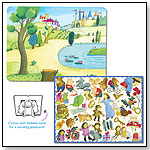 Children can direct their own stories from one of four magnetic story backgrounds: Fairytales, Robot's Landing, Animal Cottage, and Forest Adventure. Theater directors-in-training can move their magnetic figures around the scene to help tell their own original story. Launch date: January 2012. 12/9/2011 (MSRP: $14.00; Age: 5 and Up)
Children can direct their own stories from one of four magnetic story backgrounds: Fairytales, Robot's Landing, Animal Cottage, and Forest Adventure. Theater directors-in-training can move their magnetic figures around the scene to help tell their own original story. Launch date: January 2012. 12/9/2011 (MSRP: $14.00; Age: 5 and Up)
Crepe Paper Novas by eeBoo corp.
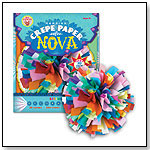 eeBoo's Paper Novas are inspired by one of the universe's most impressive phenomena - Supernovas. Each comes with 200 strips of crepe paper in vibrant colors and a length of baker's string for hanging and suspension. All are aptly named after the brightest celestial bodies seen from Earth, such as Betelgeuse, Alpha Centauri, and Vega. "Papers Novas are assembled into bundles, then gently pulled apart until they puff up - one might say "explode" - into a big, colorful 10-inch diameter ball," Regina Gelin, sales & marketing associate at eeBoo, told TDmonthly. Launch date: January 2012. 12/29/2011 (MSRP: $7.00; Age: 8 and Up)
eeBoo's Paper Novas are inspired by one of the universe's most impressive phenomena - Supernovas. Each comes with 200 strips of crepe paper in vibrant colors and a length of baker's string for hanging and suspension. All are aptly named after the brightest celestial bodies seen from Earth, such as Betelgeuse, Alpha Centauri, and Vega. "Papers Novas are assembled into bundles, then gently pulled apart until they puff up - one might say "explode" - into a big, colorful 10-inch diameter ball," Regina Gelin, sales & marketing associate at eeBoo, told TDmonthly. Launch date: January 2012. 12/29/2011 (MSRP: $7.00; Age: 8 and Up)
Mosaics by eeBoo corp.
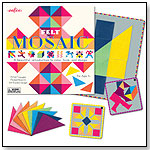 Containing 72 soft felt triangles in 9 colors, a flocked game board, and 50 illustrated cards, teach color, form, and design to kids without their knowing that they are learning the fundamentals of design. The instructions offer increasing challenges, from Elementary Figures to Negative Space to Perspective to Translucency and Representational Imagery. "Mosaics offers a highly sophisticated introduction to the basics of art and design for children," Regina Gelin, sales and marketing rep at eeBoo, told TDmonthly. Launch date: February 2012. (
Containing 72 soft felt triangles in 9 colors, a flocked game board, and 50 illustrated cards, teach color, form, and design to kids without their knowing that they are learning the fundamentals of design. The instructions offer increasing challenges, from Elementary Figures to Negative Space to Perspective to Translucency and Representational Imagery. "Mosaics offers a highly sophisticated introduction to the basics of art and design for children," Regina Gelin, sales and marketing rep at eeBoo, told TDmonthly. Launch date: February 2012. ( Watch Video) 12/9/2011 (MSRP: $18.00; Age: 5 and Up)
Watch Video) 12/9/2011 (MSRP: $18.00; Age: 5 and Up)
Life on Earth Tot Tower by eeBoo corp.
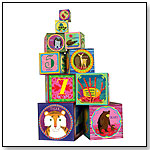 eBoo's eco-friendly Tot Towers are beautifully illustrated with the same characters from our revered "Life On Earth" series. The Tower includes ten sturdy cardboard blocks to nest, stack, and tumble down. Great for children who love to build things as much as they love to see them knocked over. "eeBoo's eco-friendly Tot Tower helps build large motor skills while promoting language and concept development," Regina Gelin, sales & marketing associate at eeBoo, told TDmonthly. Launch date: January 2012. 12/29/2011 (MSRP: $20.00; Age: 2 and Up)
eBoo's eco-friendly Tot Towers are beautifully illustrated with the same characters from our revered "Life On Earth" series. The Tower includes ten sturdy cardboard blocks to nest, stack, and tumble down. Great for children who love to build things as much as they love to see them knocked over. "eeBoo's eco-friendly Tot Tower helps build large motor skills while promoting language and concept development," Regina Gelin, sales & marketing associate at eeBoo, told TDmonthly. Launch date: January 2012. 12/29/2011 (MSRP: $20.00; Age: 2 and Up)
Art Books by eeBoo corp.
 Three of eeBoo's favorite illustrators - Kevin Hawkes, Lizzy Rockwell, and Melissa Sweet - share their love of art in this new collection of "How to Draw" Art Books. They begin with the Rockwell's intro "Learn to Draw Simple Forms in the Home & Garden"; followed by Sweet's "Drawing Book" and its clever ways of teaching children about form, light, and perspective; and finishing off with Hawkes' "Learn to Draw Animals" with his funny approach to drawing animals without fear. "Kevin Hawkes, Lizzy Rockwell, and Melissa Sweet are well-known children's illustrators who bring their love of drawing and design to these easy-to-follow instruction books," Regina Gelin, sales & marketing rep at eeBoo, told TDmonthly. Launch date: January 2012. 12/12/2011 (MSRP: $6.00; Age: 5 and Up)
Three of eeBoo's favorite illustrators - Kevin Hawkes, Lizzy Rockwell, and Melissa Sweet - share their love of art in this new collection of "How to Draw" Art Books. They begin with the Rockwell's intro "Learn to Draw Simple Forms in the Home & Garden"; followed by Sweet's "Drawing Book" and its clever ways of teaching children about form, light, and perspective; and finishing off with Hawkes' "Learn to Draw Animals" with his funny approach to drawing animals without fear. "Kevin Hawkes, Lizzy Rockwell, and Melissa Sweet are well-known children's illustrators who bring their love of drawing and design to these easy-to-follow instruction books," Regina Gelin, sales & marketing rep at eeBoo, told TDmonthly. Launch date: January 2012. 12/12/2011 (MSRP: $6.00; Age: 5 and Up)
Sidewalk Games by eeBoo corp.
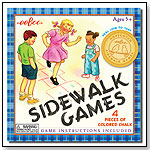 Take the fun outdoors with eeBoo Sidewalk Games. Set includes a gold coin to toss, four vibrant chalk sticks and a booklet of instructions for sidewalk games such as Hopscotch, Skelly, London Calling and more. "A child, a coin, some colored chalk bring hours of fun to a plain sidewalk. Learn games that generations played when fun and toys were all homemade!" Regina Gelin, sales & marketing associate for eeBoo, told TDmonthly. Launch date: August 2011. 9/16/2011 (MSRP: $8.50; Age: 5 and Up)
Take the fun outdoors with eeBoo Sidewalk Games. Set includes a gold coin to toss, four vibrant chalk sticks and a booklet of instructions for sidewalk games such as Hopscotch, Skelly, London Calling and more. "A child, a coin, some colored chalk bring hours of fun to a plain sidewalk. Learn games that generations played when fun and toys were all homemade!" Regina Gelin, sales & marketing associate for eeBoo, told TDmonthly. Launch date: August 2011. 9/16/2011 (MSRP: $8.50; Age: 5 and Up)
Obstacles - A Game of Imaginative Solutions by eeBoo corp.
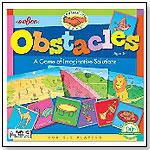 Obstacles is a journey along a path of hazards and barriers which are overcome by the collective cleverness of its players. Armed with an unlikely set of tools, imagination, and some silliness, players "cooperate" creatively to innovate solutions that let them get home together. "Obstacles is eeBoo's first "cooperative" game. It teaches the useful skill of creative collaboration and makes for a play experience that is positive and constructive as it promotes good feelings amongst players. It is a perfect game for parents, children, and siblings to be silly and imaginative together," Regina Gelin, sales and marketing associate at eeBoo, told TDmonthly. Launch date: July 2011.
Obstacles is a journey along a path of hazards and barriers which are overcome by the collective cleverness of its players. Armed with an unlikely set of tools, imagination, and some silliness, players "cooperate" creatively to innovate solutions that let them get home together. "Obstacles is eeBoo's first "cooperative" game. It teaches the useful skill of creative collaboration and makes for a play experience that is positive and constructive as it promotes good feelings amongst players. It is a perfect game for parents, children, and siblings to be silly and imaginative together," Regina Gelin, sales and marketing associate at eeBoo, told TDmonthly. Launch date: July 2011.
Awards: 2011 Oppenheim Toy Portfolio Best Toy Award - Platinum 9/8/2011 (MSRP: $17.00; Age: 5 and Up)
Cupcake Game by eeBoo corp.
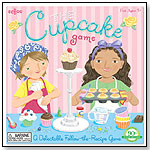 This fun game allows kids to build a cupcake of their choice. They spin to compile all the necessary ingredients. The first finished cupcake wins the game for its creator. With illustrations by children’s book illustrator Lizzy Rockwell. Launch date: 2010.
This fun game allows kids to build a cupcake of their choice. They spin to compile all the necessary ingredients. The first finished cupcake wins the game for its creator. With illustrations by children’s book illustrator Lizzy Rockwell. Launch date: 2010.
— “It’s classic just for families to get together and play,” said Devo Ihonde, explaining the appeal of this simple game that doesn’t even require reading ability. “That will always be contemporary.”
— In a February 2014 survey, Joe Novak, owner of Kazoo Toys of Buckhead in Buckhead, Ga., told TDmonthly that Eeboo's Cupcake Game was one of their stores top-3 best-selling games. 4/29/2011 (MSRP: $17.00; Age: 5 and Up)
Paper Chains by eeBoo corp.
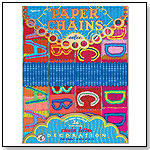 An easy craft project that is sure to have kids entertained for hours on end, eeBoo Paper Chains spruce up a room, bring life to a party or just get crafty. Each pack features 120 colorful links with easy to assemble slide-in tabs (no glue needed) and stretches 24 feet. Three paper chain designs to choose from: Animal Chain, Ribbon Chain, and Chain Letter. "Each link has a simple slot and tab, allowing the chains to be recombined and used over and over again," Regina Gelin, sales & marketing associate at eeBoo, told TDmonthly. Launch date: August 2011. 9/13/2011 (MSRP: $10.00; Age: 5 and Up)
An easy craft project that is sure to have kids entertained for hours on end, eeBoo Paper Chains spruce up a room, bring life to a party or just get crafty. Each pack features 120 colorful links with easy to assemble slide-in tabs (no glue needed) and stretches 24 feet. Three paper chain designs to choose from: Animal Chain, Ribbon Chain, and Chain Letter. "Each link has a simple slot and tab, allowing the chains to be recombined and used over and over again," Regina Gelin, sales & marketing associate at eeBoo, told TDmonthly. Launch date: August 2011. 9/13/2011 (MSRP: $10.00; Age: 5 and Up)
Copyright © 2026 TDmonthly®, a division of TOYDIRECTORY.com®,
Inc.



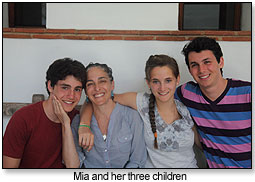
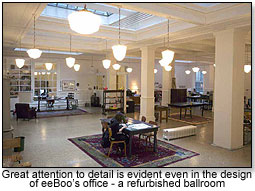
 Children can direct their own stories from one of four magnetic story backgrounds: Fairytales, Robot's Landing, Animal Cottage, and Forest Adventure. Theater directors-in-training can move their magnetic figures around the scene to help tell their own original story. Launch date: January 2012. 12/9/2011 (MSRP: $14.00; Age: 5 and Up)
Children can direct their own stories from one of four magnetic story backgrounds: Fairytales, Robot's Landing, Animal Cottage, and Forest Adventure. Theater directors-in-training can move their magnetic figures around the scene to help tell their own original story. Launch date: January 2012. 12/9/2011 (MSRP: $14.00; Age: 5 and Up) eeBoo's Paper Novas are inspired by one of the universe's most impressive phenomena - Supernovas. Each comes with 200 strips of crepe paper in vibrant colors and a length of baker's string for hanging and suspension. All are aptly named after the brightest celestial bodies seen from Earth, such as Betelgeuse, Alpha Centauri, and Vega. "Papers Novas are assembled into bundles, then gently pulled apart until they puff up - one might say "explode" - into a big, colorful 10-inch diameter ball," Regina Gelin, sales & marketing associate at eeBoo, told TDmonthly. Launch date: January 2012. 12/29/2011 (MSRP: $7.00; Age: 8 and Up)
eeBoo's Paper Novas are inspired by one of the universe's most impressive phenomena - Supernovas. Each comes with 200 strips of crepe paper in vibrant colors and a length of baker's string for hanging and suspension. All are aptly named after the brightest celestial bodies seen from Earth, such as Betelgeuse, Alpha Centauri, and Vega. "Papers Novas are assembled into bundles, then gently pulled apart until they puff up - one might say "explode" - into a big, colorful 10-inch diameter ball," Regina Gelin, sales & marketing associate at eeBoo, told TDmonthly. Launch date: January 2012. 12/29/2011 (MSRP: $7.00; Age: 8 and Up) Containing 72 soft felt triangles in 9 colors, a flocked game board, and 50 illustrated cards, teach color, form, and design to kids without their knowing that they are learning the fundamentals of design. The instructions offer increasing challenges, from Elementary Figures to Negative Space to Perspective to Translucency and Representational Imagery. "Mosaics offers a highly sophisticated introduction to the basics of art and design for children," Regina Gelin, sales and marketing rep at eeBoo, told TDmonthly. Launch date: February 2012. (
Containing 72 soft felt triangles in 9 colors, a flocked game board, and 50 illustrated cards, teach color, form, and design to kids without their knowing that they are learning the fundamentals of design. The instructions offer increasing challenges, from Elementary Figures to Negative Space to Perspective to Translucency and Representational Imagery. "Mosaics offers a highly sophisticated introduction to the basics of art and design for children," Regina Gelin, sales and marketing rep at eeBoo, told TDmonthly. Launch date: February 2012. (![]() Watch Video) 12/9/2011 (MSRP: $18.00; Age: 5 and Up)
Watch Video) 12/9/2011 (MSRP: $18.00; Age: 5 and Up) eBoo's eco-friendly Tot Towers are beautifully illustrated with the same characters from our revered "Life On Earth" series. The Tower includes ten sturdy cardboard blocks to nest, stack, and tumble down. Great for children who love to build things as much as they love to see them knocked over. "eeBoo's eco-friendly Tot Tower helps build large motor skills while promoting language and concept development," Regina Gelin, sales & marketing associate at eeBoo, told TDmonthly. Launch date: January 2012. 12/29/2011 (MSRP: $20.00; Age: 2 and Up)
eBoo's eco-friendly Tot Towers are beautifully illustrated with the same characters from our revered "Life On Earth" series. The Tower includes ten sturdy cardboard blocks to nest, stack, and tumble down. Great for children who love to build things as much as they love to see them knocked over. "eeBoo's eco-friendly Tot Tower helps build large motor skills while promoting language and concept development," Regina Gelin, sales & marketing associate at eeBoo, told TDmonthly. Launch date: January 2012. 12/29/2011 (MSRP: $20.00; Age: 2 and Up) Three of eeBoo's favorite illustrators - Kevin Hawkes, Lizzy Rockwell, and Melissa Sweet - share their love of art in this new collection of "How to Draw" Art Books. They begin with the Rockwell's intro "Learn to Draw Simple Forms in the Home & Garden"; followed by Sweet's "Drawing Book" and its clever ways of teaching children about form, light, and perspective; and finishing off with Hawkes' "Learn to Draw Animals" with his funny approach to drawing animals without fear. "Kevin Hawkes, Lizzy Rockwell, and Melissa Sweet are well-known children's illustrators who bring their love of drawing and design to these easy-to-follow instruction books," Regina Gelin, sales & marketing rep at eeBoo, told TDmonthly. Launch date: January 2012. 12/12/2011 (MSRP: $6.00; Age: 5 and Up)
Three of eeBoo's favorite illustrators - Kevin Hawkes, Lizzy Rockwell, and Melissa Sweet - share their love of art in this new collection of "How to Draw" Art Books. They begin with the Rockwell's intro "Learn to Draw Simple Forms in the Home & Garden"; followed by Sweet's "Drawing Book" and its clever ways of teaching children about form, light, and perspective; and finishing off with Hawkes' "Learn to Draw Animals" with his funny approach to drawing animals without fear. "Kevin Hawkes, Lizzy Rockwell, and Melissa Sweet are well-known children's illustrators who bring their love of drawing and design to these easy-to-follow instruction books," Regina Gelin, sales & marketing rep at eeBoo, told TDmonthly. Launch date: January 2012. 12/12/2011 (MSRP: $6.00; Age: 5 and Up) Take the fun outdoors with eeBoo Sidewalk Games. Set includes a gold coin to toss, four vibrant chalk sticks and a booklet of instructions for sidewalk games such as Hopscotch, Skelly, London Calling and more. "A child, a coin, some colored chalk bring hours of fun to a plain sidewalk. Learn games that generations played when fun and toys were all homemade!" Regina Gelin, sales & marketing associate for eeBoo, told TDmonthly. Launch date: August 2011. 9/16/2011 (MSRP: $8.50; Age: 5 and Up)
Take the fun outdoors with eeBoo Sidewalk Games. Set includes a gold coin to toss, four vibrant chalk sticks and a booklet of instructions for sidewalk games such as Hopscotch, Skelly, London Calling and more. "A child, a coin, some colored chalk bring hours of fun to a plain sidewalk. Learn games that generations played when fun and toys were all homemade!" Regina Gelin, sales & marketing associate for eeBoo, told TDmonthly. Launch date: August 2011. 9/16/2011 (MSRP: $8.50; Age: 5 and Up) Obstacles is a journey along a path of hazards and barriers which are overcome by the collective cleverness of its players. Armed with an unlikely set of tools, imagination, and some silliness, players "cooperate" creatively to innovate solutions that let them get home together. "Obstacles is eeBoo's first "cooperative" game. It teaches the useful skill of creative collaboration and makes for a play experience that is positive and constructive as it promotes good feelings amongst players. It is a perfect game for parents, children, and siblings to be silly and imaginative together," Regina Gelin, sales and marketing associate at eeBoo, told TDmonthly. Launch date: July 2011.
Obstacles is a journey along a path of hazards and barriers which are overcome by the collective cleverness of its players. Armed with an unlikely set of tools, imagination, and some silliness, players "cooperate" creatively to innovate solutions that let them get home together. "Obstacles is eeBoo's first "cooperative" game. It teaches the useful skill of creative collaboration and makes for a play experience that is positive and constructive as it promotes good feelings amongst players. It is a perfect game for parents, children, and siblings to be silly and imaginative together," Regina Gelin, sales and marketing associate at eeBoo, told TDmonthly. Launch date: July 2011.  This fun game allows kids to build a cupcake of their choice. They spin to compile all the necessary ingredients. The first finished cupcake wins the game for its creator. With illustrations by children’s book illustrator Lizzy Rockwell. Launch date: 2010.
This fun game allows kids to build a cupcake of their choice. They spin to compile all the necessary ingredients. The first finished cupcake wins the game for its creator. With illustrations by children’s book illustrator Lizzy Rockwell. Launch date: 2010. An easy craft project that is sure to have kids entertained for hours on end, eeBoo Paper Chains spruce up a room, bring life to a party or just get crafty. Each pack features 120 colorful links with easy to assemble slide-in tabs (no glue needed) and stretches 24 feet. Three paper chain designs to choose from: Animal Chain, Ribbon Chain, and Chain Letter. "Each link has a simple slot and tab, allowing the chains to be recombined and used over and over again," Regina Gelin, sales & marketing associate at eeBoo, told TDmonthly. Launch date: August 2011. 9/13/2011 (MSRP: $10.00; Age: 5 and Up)
An easy craft project that is sure to have kids entertained for hours on end, eeBoo Paper Chains spruce up a room, bring life to a party or just get crafty. Each pack features 120 colorful links with easy to assemble slide-in tabs (no glue needed) and stretches 24 feet. Three paper chain designs to choose from: Animal Chain, Ribbon Chain, and Chain Letter. "Each link has a simple slot and tab, allowing the chains to be recombined and used over and over again," Regina Gelin, sales & marketing associate at eeBoo, told TDmonthly. Launch date: August 2011. 9/13/2011 (MSRP: $10.00; Age: 5 and Up)